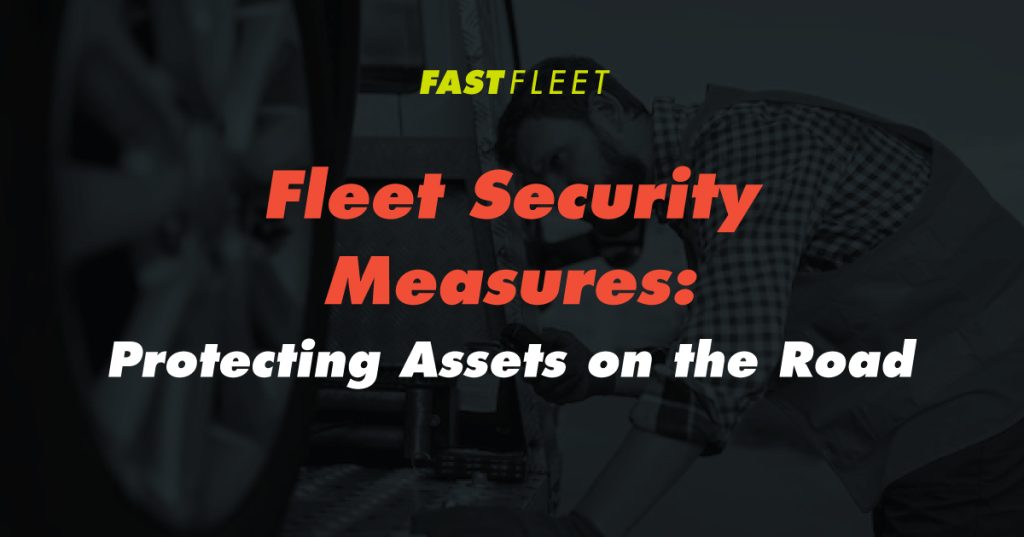Ensuring the security of fleet assets is paramount for any commercial vehicle operation.
Fleet managers face numerous challenges in safeguarding vehicles, cargo, and personnel against theft, vandalism, and other security threats while on the road.
From protecting valuable assets to ensuring the safety of drivers and crew members, implementing robust security measures is essential to maintain operational efficiency and mitigate risks.
In this blog, we will delve into the world of fleet security measures and protocols designed to protect assets on the road.
We will explore key areas of focus, including vehicle security, cargo security, and personnel safety, and discuss practical strategies that fleet managers can implement to enhance security across their operations.
By understanding the importance of fleet security and adopting proactive measures, fleet managers can safeguard their assets and maintain the integrity of their operations.
Vehicle Security:
Ensuring the security of commercial vehicles is essential to prevent theft, vandalism, and unauthorized access. Here are key strategies for enhancing vehicle security:
GPS Tracking Systems:
Implementing GPS tracking systems allows fleet managers to monitor the location and movement of vehicles in real-time.
These systems provide valuable insights into vehicle whereabouts, helping to prevent theft and unauthorized use.
In the event of a security breach, GPS tracking enables quick recovery and retrieval of stolen vehicles.
Vehicle Immobilization Devices:
Installing vehicle immobilization devices, such as steering wheel locks and ignition kill switches, adds an extra layer of security against theft.
These devices deter unauthorized individuals from starting or moving the vehicle without proper authorization, reducing the risk of vehicle theft.
Secure Parking Facilities:
Encouraging drivers to park vehicles in secure, well-lit areas with surveillance cameras can help minimize the risk of theft and vandalism.
Utilizing designated truck stops or secured parking lots equipped with security features enhances vehicle security and provides peace of mind for fleet managers.
Regular Vehicle Inspections:
Conducting routine inspections of vehicles to identify and address any vulnerabilities or security risks is crucial.
Fleet managers should ensure that all vehicle locks, windows, and security features are functioning correctly to prevent potential security breaches.
Driver Training:
Educating drivers on vehicle security protocols and best practices is essential. Drivers should be trained to lock vehicles when unattended, avoid leaving valuables in plain sight, and report any suspicious activities or security concerns promptly.
By instilling a culture of security awareness among drivers, fleet managers can further enhance vehicle security.
Implementing robust vehicle security measures not only protects valuable assets but also contributes to the overall safety and security of fleet operations.
By investing in advanced security technologies and promoting security-conscious behavior among drivers, fleet managers can minimize the risk of vehicle-related security incidents and maintain the integrity of their operations.
Fleet Cargo Security:
Protecting cargo from theft and tampering is paramount for fleet managers to ensure the integrity of shipments and maintain customer trust.
Here are effective strategies for enhancing cargo security:
Secure Load Securement:
Properly securing cargo within vehicles is essential to prevent shifting, spillage, or theft during transit.
Fleet managers should ensure that all cargo is adequately secured using appropriate tie-downs, straps, or locks.
Regular inspections should be conducted to verify the integrity of load securement devices and address any issues promptly.
Tracking and Monitoring Systems:
Implementing tracking and monitoring systems for cargo allows fleet managers to monitor the location and condition of shipments throughout transit.
Advanced tracking technologies, such as RFID tags or GPS-enabled sensors, provide real-time visibility into cargo movements and alert managers to any unauthorized deviations or disruptions in transit.
Tamper-Evident Seals:
Utilizing tamper-evident seals on cargo containers and trailers adds an additional layer of security against tampering and unauthorized access.
These seals are designed to show visible signs of tampering if removed or breached, alerting personnel to potential security breaches and ensuring the integrity of cargo shipments.
Secure Storage Facilities:
When cargo needs to be temporarily stored or transferred between vehicles, fleet managers should ensure that secure storage facilities are utilized.
These facilities should be equipped with security features such as access control systems, surveillance cameras, and perimeter fencing to deter theft and unauthorized access.
Driver Training and Awareness:
Educating drivers on cargo security protocols and procedures is crucial for maintaining the security of shipments.
Drivers should be trained to conduct pre-trip inspections of cargo to ensure it is properly secured and to remain vigilant for any signs of tampering or suspicious activity during transit.
By promoting a culture of cargo security awareness among drivers, fleet managers can minimize the risk of cargo-related security incidents.
By implementing these cargo security measures, fleet managers can safeguard valuable shipments, mitigate the risk of theft or tampering, and ensure the timely and secure delivery of goods to customers.
Prioritizing cargo security not only protects the interests of the fleet and its customers but also enhances the reputation and reliability of the fleet’s services.
Personnel Security:
Ensuring the safety and security of personnel is paramount for fleet managers. Here are key strategies for enhancing personnel security:
Background Checks:
Conducting thorough background checks on all employees, including drivers, mechanics, and administrative staff, can help identify any history of criminal activity or security risks.
Background checks should be conducted as part of the hiring process and periodically throughout employment to ensure ongoing security compliance.
Access Control:
Implementing access control measures, such as ID badges, keycards, or biometric systems, can restrict unauthorized access to fleet facilities, vehicles, and sensitive areas.
Access control systems help prevent unauthorized entry by limiting access to authorized personnel only and can track and monitor employee movements for security purposes.
Training and Awareness Programs:
Providing comprehensive security training and awareness programs to all personnel is essential to educate employees about security risks, threats, and procedures.
Training should cover topics such as recognizing suspicious behavior, responding to security incidents, and reporting security concerns to appropriate authorities.
Emergency Response Plans:
Developing and implementing emergency response plans that outline procedures for responding to security threats, emergencies, or incidents is critical for ensuring the safety of personnel.
Emergency response plans should include protocols for evacuations, lockdowns, and communication with emergency services to mitigate security risks effectively.
Communication Systems:
Implementing reliable communication systems, such as two-way radios, mobile phones, or panic buttons, can facilitate quick and effective communication between personnel in the event of a security incident.
Communication systems enable employees to alert authorities or request assistance promptly, enhancing overall security and safety.
Physical Security Measures:
Installing physical security measures, such as surveillance cameras, alarm systems, and perimeter fencing, can deter unauthorized access, monitor employee activities, and provide evidence in the event of security breaches.
Physical security measures should be integrated into overall security plans to create a comprehensive security framework.
By prioritizing personnel security and implementing these strategies, fleet managers can create a safe and secure working environment for employees, minimize security risks, and protect against potential threats to personnel safety.
Investing in personnel security measures demonstrates a commitment to employee well-being and helps build trust and confidence among workforce members.
Investing in cargo security demonstrates a commitment to customer satisfaction, operational excellence, and brand reputation in the industry.
Ensuring the security of your fleet, personnel, and assets is paramount in today’s challenging operating environment.
By implementing robust security measures, including vehicle tracking systems, cargo security protocols, facility security enhancements, and personnel security measures, fleet managers can effectively mitigate security risks and safeguard their operations.
Investing in security solutions not only protects against potential threats but also instills confidence among stakeholders, enhances operational efficiency, and contributes to the overall success of the fleet.
As technology continues to evolve and new security challenges emerge, staying proactive and adaptable is essential.
At Fast Fleet, we understand the importance of fleet security and offer comprehensive solutions tailored to meet the unique needs of our clients.
From advanced telematics systems to cargo tracking and monitoring solutions, we provide the tools and support necessary to enhance security and ensure peace of mind on the road.
Partner with Fast Fleet today to strengthen your fleet’s security posture and protect your assets against evolving security threats.
Together, we can navigate the road ahead with confidence and security.
If you’re ready to take the next step in securing your fleet, contact us today to learn more about our security solutions and how we can support your fleet’s security objectives.
















